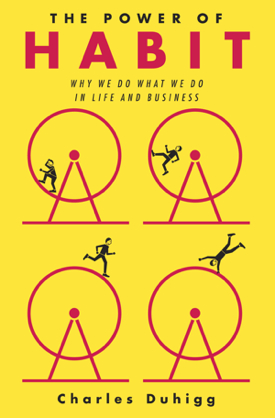Steve Silberman, science writer (whom I adore and follow on Twitter: @stevesilberman), has just posted a new piece on NeuroTribes: mind, science culture, one of my favorite blogs. It’s a Q&A with New York Times reporter Charles Duhigg on his new book The Power of Habit.
(And I must say that after the William J. Broad experience — “yoga is not only killing us but began as a Tantric sex cult”– it is sweet to learn of a Times reporter who’s really done his homework and offered something very valuable. Kudos, Charles Duhigg.)
Silberman lets us know up front how habitual we are.
Indeed, we spend more than 40 percent of our precious waking hours engaged in habitual actions [PDF], according to a 2006 study at Duke University. Welcome to the machine.
No wonder mindfulness has become something we seek. To connect with someone or something not out of habit, but out of something like our original self — that’s the stuff that peak experiences, connecting to the Source, the most alive life are made of.
It’s as if our brains store habitual behavior in a locked box to prevent tampering by the more mindful angels of our nature…
In his provocative and brilliantly written new book, The Power of Habit, Charles Duhigg … pries open the box with the help of recent research and finds surprising good news: Even the most thoughtless and self-destructive cycles of behavior can be changed, if you understand how habits are formed and stored in memory.
Duhigg breaks down the sequence of ritualized behavior (which he calls the habit loop) into three component parts: the cue, the routine, and the reward. The cue is the trigger that sets the sequence in motion…. The routine is the behavior itself, which can be positive (like a daily running habit) or harmful (like gambling away the family savings). And the third part is the reward — the goal of the behavioral loop, which your brain’s pleasure centers gauge to determine if a sequence of behavior is worth repeating and storing in a lockbox of habit….
Duhigg … maps out a more effective path toward enduring habit change that focuses not on trying to scrap the routine all at once, but on becoming aware of the cues and manipulating the rewards. The encouraging news is that success in making modest alterations in behavior (which Duhigg calls “small wins”) creates a ripple effect into other areas of your life….
We know from studies that almost all cues — the stimuli that elicit the habitual behavior — fall into one of five categories. It’s time of day, or a certain place, or a certain emotion, or the presence of certain people, or a preceding action that’s become habitual or ritualized….
Then you focus on the rewards. The first couple of times you go running, you’re not going to enjoy it. No one enjoys it the first time they run. So you have to give yourself a piece of chocolate when you get back from the run. You have to have some immediate reward. And we know from studies that within two weeks, the intrinsic reward of running — the endocannabinoids unleashed by exercising — are going to become enough of a reward to create that habit. But you have to trick your brain into it by giving yourself a piece of chocolate the first couple times….
If you want to start running every day, just start by putting on your running shoes at the same time every day. Then you’ll feel more like running. Then you’ll run!
If I want to meditate more regularly, I can tell myself that I just need to sit for 5 minutes each morning, or 2 minutes each evening. Once I actually sit for those small lengths of time, I’m much more likely to sit for 20 or 30 minutes.
These two guys then begin discussing the civil rights movement, the gay marriage movement, and more. To read the whole post, click here.

